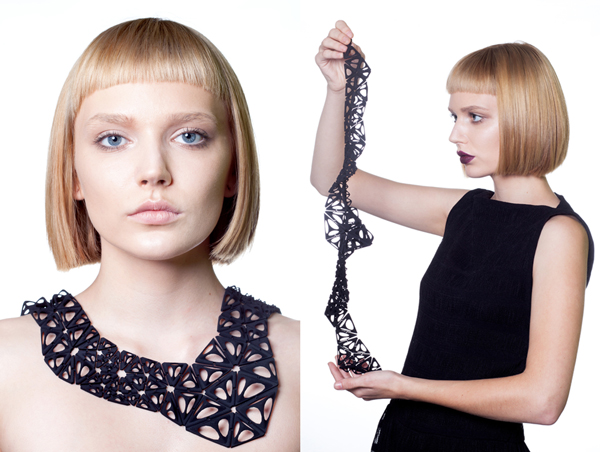Nervous System Brings 4D Printing Out of the Lab

This necklace design was printed in one piece thanks to the 3D printing design process called Kinematics by Nervous System. Courtesy of Nervous System.
Latest News
December 17, 2013
One of the limiting factors for parts and products produced through additive manufacturing (AM) is the build size of the 3D printer in use. Larger AM systems tend to be more expensive to both purchase and to run (more material usage), but do allow for larger batch runs and designs to be built in one piece rather than several. Cutting a design into pieces is just one method of overcoming limited build space. A manufacturing and design process dubbed 4D printing is another.
With 4D printing, objects can be squashed down in size by varying the density of the object and building an object out of multiple smaller parts. This allows for objects to be build that far exceed the size of the print envelope. Until recently, 4D printing has mainly been an exercise in theory, but a company named Nervous System has brought the process out of the lab and into retail space.

Nervous System was launched by Jessica Rosenkrantz and Jesse Louis-Rosenberg, both graduates of MIT. When the company founders speak you can hear the echoes of Neri Oxman, leader of the school’s mediated matter group in the MIT Media Lab. Nervous Systems draws inspiration from nature to compliment CAD design for 4D printing, which the company refers to as “Kinematics.”
From the website:
Formally we are attracted to complex and unconventional geometries. Our inspirations are grounded in the natural forms and corresponding processes which construct the world around us. From coral aggregations to interference patterns, a study of natural phenomena is an essential ingredient to our design process.To evolve such forms, we systematically engage in generative processes. Instead of designing a specific form, we craft a system whose result is a myriad of distinct creations. These systems are interactive, responding both to changes in specific variables and to physical inputs. There is no definitive, final product, instead the many designs created allow for mass customization.
Rather than apply AM and Kinematics to the production of large-scale objects, Nervous System has instead turned to manufacturing jewelry, puzzles, and other, smaller, objects. This allows the company to create bespoke items that are even more customizable than is normally true for 3D printed products. The addition of 4D printing expands both the size of objects offered, and the possibilities for appearance.
Users can personalize products even further by using a deceptively simple design suite to build their own jewelry. The design application operates on the basic principles of the generative process and includes a tutorial for first time users, the majority of whom will never realize the complexity of the program that just made them a new bracelet.
Below you’ll find a couple videos. The first is a brief overview of Kinematics, and the second is a quick look at Nervous System.
Source: Nervous System






